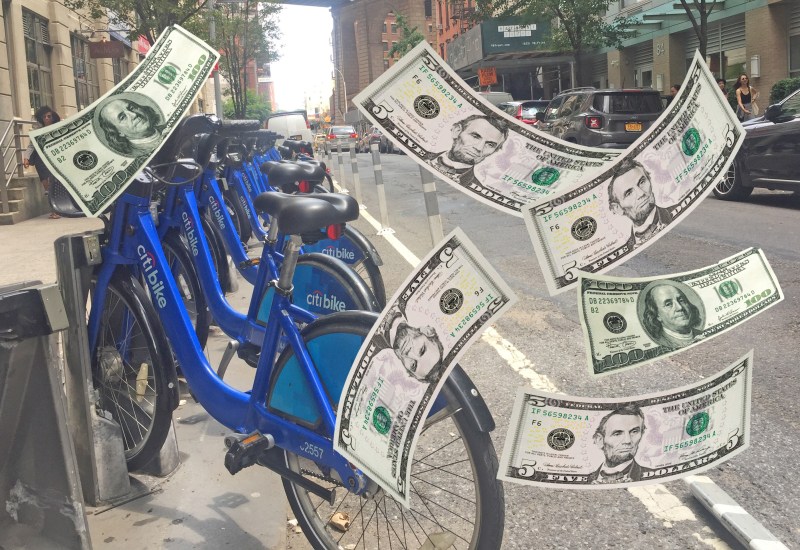Citi Bike Raises Fees as Advocates Urge Mayor Adams to Keep His Promise of Public Funding


Happy New Year, Citi Bike members — now, pay up.
The Lyft-owned bike-share system announced this afternoon that it was raising fees across the board — a price hike that is the result of inflation, expansion costs and the city’s continued failure to subsidize a crucial form of public transit that moves scores of thousands of people daily.
At 1 p.m., Citi Bike emailed its 215,000 members the bad news:
- Annual memberships will rise to $205 from the current $185.
- Single trips passes will increase to $4.49 from $3.99.
- All-day passes will increase to $19 from $15.
- E-bike fees are going up, too:
- Members will now pay 17 cents per minute, up from 15 cents a minute. (Reminder: If there are no bikes other than electric bikes available at a dock, that fee is waived.)
- Non-members will pay 26 cents per minute, up from 23 cents a minute.
On the plus side, the Reduced Fare Bike Share program — which gives NYCHA residents $5-a-month memberships — will not increase in membership cost (though per-ride fees will rise to 6 cents per minute from the current 5 cents per minute).
The company pointed out that the yearly membership still works out to just $17.08 per month — far less than a monthly MetroCard, which costs $127. The higher fees reflect ongoing supply chain disruptions that are causing material and shipping costs to rise faster than inflation.
The company pointed out that the annual pass still provides members with unlimited 45-minute rides on a standard pedal bike. Annual members took 75 percent of all rides, the company said.
In a statement, Lyft clearly reminded city officials, without actually saying it, that it is time for the system to get the same thing that every other form of public transit gets — some public subsidy — as it continues to grow its fleet to 40,000 bikes by 2024.
“Our team is made of passionate riders who use the system daily,” the statement said. “We are all committed to working with our city partners and doing our best to provide world-class service, create enhanced value for members, and increase equitable access for clean transportation options, while running a financially sustainable system.”

Advocates were equally insistent that Mayor Adams address his campaign promise to help subsidize Citi Bike, whose expansion deeper into Brooklyn, the Bronx and Queens will continue into 2024 (see map) before the company can enter what it calls its Phase IV expansion.
“With record bike share ridership, New Yorkers are sending a clear message in support of affordable, sustainable, and reliable ways to get around the city,” said Elizabeth Adams, senior director of Advocacy & Organizing at Transportation Alternatives. “It’s time for our elected leaders to fund bike share — like they do every other transportation system in the city — to keep down prices and to ensure the system is expanded to every neighborhood in every borough. Public funding for bike share will help get people out of cars, encouraging sustainable transportation, while reducing air pollution and traffic violence.”
Citi Bike’s annual members are likely to take the fee increase in stride, given that the increase will amount to pennies per ride. The average annual member took 130 rides last year, the company said, which is more than 20 times the average for non-members. At that average, a member pays about $1.57 per ride on a pedal bike (though that average cost obviously includes particularly active “Bike Angels” who ride around all day replenishing stations).
Overall, Citi Bike carried 30.5 million rides in 2022. That’s more than the public transit systems of many American cities. By comparison, the New York City ferry system, which is highly subsidized, carried about 4.8 million passengers between January and October.
Citi Bike’s electric fleet, which number about 4,000 bicycles, is also costing the company more to operate. The city and Con Edison were supposed to be working with Citi Bike to connect docking stations to the electric grid so that bikes could charge while docked, rather than require workers to scurry around replacing batteries. The city has not provided an update on that plan.
Citi Bike is the one bright spot on Lyft’s ledger sheet. The bike share system runs at a slight loss, but it’s nothing compared to the red ink bleeding out of the company headquarters. According to its recent posting, the company’s losses in the third quarter of 2022 were $422.2 million (up from a net loss of $99.7 million in the same period of 2021, and a net loss of $377.2 million in the second quarter of 2022).
City Hall did not respond to an email seeking comment, but DOT spokesman Vin Barone did not dismiss the notion of a public subsidy at some point.
“DOT’s goal is to provide New Yorkers equitable, safe, and convenient bike share service,” he said. “We continue to discuss with our service provider how to achieve these mutual goals.”





